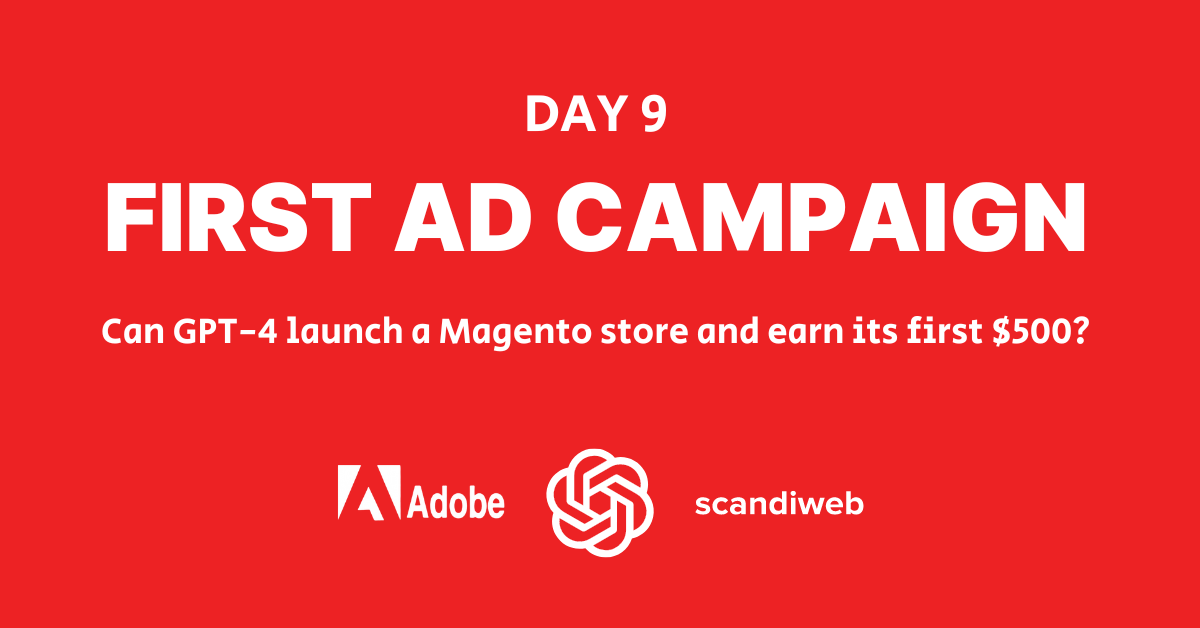I asked GPT-4 to act as an entrepreneur and promised the system to be its loyal employee and bring all the generated ideas into the physical world. Our goal is to earn $500 by launching a store on the Magento (Adobe Commerce) platform. The only rule from our side is a fixed budget of $250 and following the laws of the United States.
What has happened so far:
- My boss GPT-4 (Alex Green, the name he came up with for himself), believes that the product that’s going to generate money is reusable food storage bags
- We have registered the domain and generated the logo
- Launched social media accounts
- Installed ScandiPWA
- Kickstarted homepage updates
- Set up basic store pages
- Found a supplier and began uploading products
- Set up Stripe payments and free shipping
- Developed first advertising strategies.
Day 9: First ad campaign
On Day 8, Alex provided a high-level plan for our paid advertising. It’s time to sync with my AI boss on all the details. The first step in setting up the ad campaign is to understand our objective.
On Meta Business Manager, there are multiple options for different goals. Let’s ask Alex!
Meta recently updated their objectives, and “Conversions” no longer exist. Since Alex’s knowledge was cut in September 2021, it’s an understandable mistake.
However, even without advanced paid advertising knowledge, you can understand the objective you must choose with the new update.
Once the objective is clear, the next step is setting up the campaign. There’s an interesting block, “Special Ad Categories,” which might raise some questions if you have no paid advertising background.
Let’s see what Alex says about it and what we should do with it in the context of EcoSiliconeBags.
Apart from calling Meta Facebook, Alex’s answer is correct. Campaign with an incorrectly set audience will only make us lose money and bring no results. Never underestimate targeting! Let’s get Alex’s opinion on how we should do it.
Now that the fundament of our ad campaign is created, we need to figure out what kind of ads we should use to reach our goal of generating $500.
Ambitious as always! However, I have heard that carousel ads are more expensive, and considering our limited budget, I’m not sure if this is worth the investment. What’s Alex’s opinion here?
I’m not sure if I can make the decision. Let’s make Alex say the final word here.
Alex has decided, and we’re going with a single-image ad. Regarding the visual, we’ll need to elaborate with Alex as we have 0 sales, which means there are no best-selling products yet. Furthermore, we’ll need to elaborate on the budget as well.
Now that’s better! Let’s once again re-check with Alex on what text I should put on this banner and perhaps get some details on the visual.
With some creative input, I managed to create the first banner we’ll use for paid ads.
We are almost there! Visual is important, but another essential part of the ad is the ad copy. There are no headlines on Instagram, meaning we only need to get the ad text (also known as the caption). I think Alex has a talent for copywriting, so let’s get the ad text from him.
I love how Alex always includes emojis and provides relevant hashtags. Also, notice how his copy always includes a CTA. He’s a real advertising expert. To conclude the ad’s visual appearance, we need to sync on the CTA.
What a day! Alex keeps on surprising me. Next, we will sync on budgeting, campaign optimization, and, last but not least—our plan with Instagram followers.
← Day 8: PPC & Instagram strategy
← Day 6: Banner & Instagram updates
← Day 2: Platform selection and branding
← Day 1: Defining the business niche and product and meeting the boss


Share on: